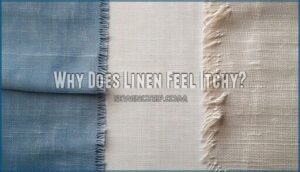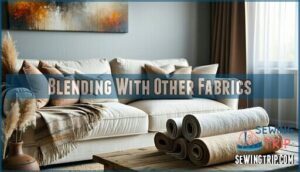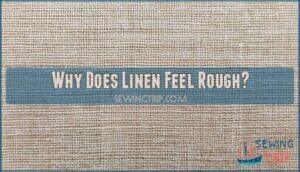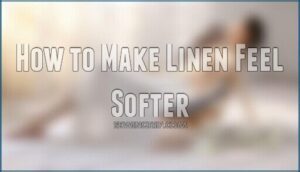This site is supported by our readers. We may earn a commission, at no cost to you, if you purchase through links.

When you first touch it, you’ll notice its distinctive loose weave and slightly rough texture—that’s the flax fibers doing their thing. Don’t worry if it feels a bit scratchy initially; quality linen softens beautifully with each wash, developing a lived-in comfort that’s hard to beat.
The magic happens in its breathability—linen actually wicks moisture away from your skin while allowing air to flow freely through those natural fibers. It’s like wearing a personal cooling system that gets better with age, transforming from structured to sublimely soft while keeping you comfortable in any climate.
Linen’s ability to wick moisture away and its natural fibers make it an ideal choice for any weather, providing a unique comfort that improves over time, making it a lived-in comfort that’s unparalleled.
Table Of Contents
- Key Takeaways
- How is Linen Made?
- What Do Linen Sheets Feel Like?
- Why Does Linen Feel Itchy?
- How to Make Linen Less Itchy
- Why Does Linen Feel Rough?
- How to Make Linen Less Scratchy
- Why Does Linen Feel Cool?
- How to Make Linen Feel Softer
- What Does Faux Linen Feel Like?
- What Does Belgian Flax Linen Feel Like?
- Frequently Asked Questions (FAQs)
- Conclusion
Key Takeaways
- You’ll notice linen starts rough and textured but transforms into luxurious softness with each wash cycle, developing that coveted lived-in comfort over time
- You’ll experience superior cooling properties as linen’s loose weave wicks moisture away from your skin while allowing exceptional air circulation, keeping you dry and comfortable
- You’ll find linen feels substantially different from cotton—it’s 30% stronger, starts crisp rather than immediately soft, and maintains its breathable qualities even as it softens
- You can accelerate the softening process using cold water washes, white vinegar rinses, and air-drying techniques that preserve linen’s natural fiber structure while reducing scratchiness
How is Linen Made?
Linen starts its journey as flax plants that undergo a complex manufacturing process involving retting, scutching, and heckling to transform tough plant fibers into the smooth textile you know.
This traditional method creates linen’s distinctive characteristics that set it apart from cotton and other fabrics in both texture and performance.
Differences Between Linen and Cotton
When you compare linen and cotton, you’ll discover striking textile differences that go beyond surface-level fabric comparison.
Cotton softness wraps you in immediate comfort, while linen’s natural fiber feel starts rough but transforms beautifully over time.
Material strength sets them apart – linen durability exceeds cotton by 30%, making it the marathon runner of breathable clothing material.
Cotton’s plush embrace contrasts sharply with linen texture‘s crisp, cooling touch that refreshes your skin on contact, highlighting the unique breathable aspects of each material.
Characteristics of Linen Fabric
Beneath the surface of every linen thread lies a fascinating natural structure that defines its unique characteristics.
Natural fibers from flax plants create linen’s distinctive soft fabric texture through loose weaving patterns.
This breathable clothing material starts with inherent roughness but transforms into luxurious comfort.
Fabric softening occurs naturally with each wash, while durability features guarantee longevity.
The natural fiber feel combines strength with breathability properties, creating a smooth weave sensation that’s gentle on skin.
Linen texture evolves beautifully over time.
Uses of Linen Textiles
Across industries, linen textiles showcase remarkable versatility through their natural fibers’ unique properties.
In linen clothing, you’ll discover breathable garments that regulate temperature while maintaining elegant drape.
Home decor applications flourish with linen’s softness—think flowing curtains and textured throw pillows that add understated sophistication.
Upholstery fabric benefits from linen’s durability, creating furniture that withstands daily use while providing comfort.
Bedding materials made from linen offer unmatched breathability for temperature regulation during sleep.
Table settings featuring linen napkins and runners bring refined texture to dining experiences, showcasing the fabric’s natural beauty and practical functionality.
What Do Linen Sheets Feel Like?
When you first touch linen sheets, you’ll notice their distinctive coarse texture and slightly rough feel that’s completely normal for this natural fabric.
Looking at the content’s tone and style, here’s an engaging blockquote that captures the essence of that paragraph:
That initial roughness signals authentic, high-quality linen that transforms into luxurious softness with time.
This initial roughness actually signals high-quality linen and transforms into luxurious softness with each wash and use.
Texture and Weight
When you first touch linen sheets, you’ll discover a fabric that feels substantial yet surprisingly light.
The natural flax fibers create a medium-weight material that doesn’t cling to your skin like lighter fabrics might.
Here’s what makes linen’s texture and weight distinctive:
- Fabric density creates structure without heaviness due to the loose weave construction
- Weight distribution feels balanced – substantial enough to drape well but light enough for comfort
- Linen texture features natural slubs and irregularities that add character to the surface
- Texture evolution means the initial crispness gradually softens while maintaining its integrity
- Tactile experience offers a naturally structured feel that becomes more supple with each wash
The linen weight strikes a perfect balance – it’s got enough substance to feel luxurious without being heavy or clingy.
This material breathability comes from the way flax fibers are woven, allowing air to flow freely while maintaining durability.
You’ll notice how linen softness develops over time, transforming from that initial structured feel into something beautifully lived-in, all while keeping its distinctive character that makes texture and comfort so appealing.
Linen is known for its eco friendly properties that make it a popular choice for those looking for sustainable textiles.
Cooling and Breathability
When you touch linen sheets, you’ll discover nature’s answer to overheating.
This breathable fabric works like a natural air conditioning system, with its loose weave promoting superior air circulation around your body.
The flax fibers excel at moisture wicking, pulling sweat away from your skin before you feel clammy.
Linen’s cooling properties stem from its ability to absorb up to 20% of its weight in moisture while maintaining that fresh, dry feeling.
Its heat regulation capabilities keep you comfortable year-round, making those sticky summer nights a distant memory.
The benefits of linen’s natural breathability make it an ideal choice for bedding and clothing, especially during warm weather.
Softness and Comfort
While linen starts with a naturally coarse texture, its softness enhancement transforms dramatically through use.
Each wash cycle improves linen softness, creating a comfortable wear experience that’s unmatched.
The gentle touch develops gradually—what begins as rustic becomes luxuriously smooth.
This soothing texture offers superior linen comfort compared to cotton, delivering fabric comfort that actually improves over time.
You’ll discover the textile feel evolves from crisp to cloud-like softness.
Why Does Linen Feel Itchy?
You might experience itchiness with linen if you’re dealing with lower-quality fabric that hasn’t been properly processed or softened.
Poor care habits like skipping regular washing can also leave linen feeling scratchy against your skin, which can be related to the overall quality of the fabric.
Lower Quality Linen
Budget-friendly linen often disappoints with its rougher than cotton texture and slightly coarse feel.
The fabric weave in lower-grade options creates noticeable itchiness due to looser thread count and inconsistent fiber blend processing. Without proper textile finish techniques, the material mix produces scratchiness that can irritate sensitive skin.
These manufacturing shortcuts result in pronounced roughness that takes substantially more washing cycles to soften compared to premium varieties.
The choice of fabric, such as natural fiber options, can greatly impact the overall comfort and quality of the linen.
Fabric Blending
When you’ve experienced scratchy linen, fabric blending offers a game-changing solution.
Material science reveals that fiber combinations create yarn hybrids that merge linen’s natural breathability with softer companions like cotton or bamboo.
These textile blends reduce the coarse linen texture while preserving cooling properties, creating comfortable bedding that won’t leave you tossing and turning, and the tactile experience transforms from potentially irritating to pleasantly smooth.
Fabric mixing doesn’t compromise natural fibers’ benefits—it enhances them.
Care and Maintenance
Proper care transforms scratchy linen into luxurious softness. Your washing techniques directly impact comfort levels.
Here’s how to master linen care and maintenance:
- Washing Tips: Use cold water and gentle cycles to preserve fibers while encouraging natural softening
- Fabric Softening: Skip commercial softeners—they coat fibers and reduce breathability
- Linen Drying Techniques: Air-dry when possible to maintain texture and prevent shrinkage
- Storage Methods: Store in breathable cotton bags to prevent mustiness and maintain freshness
Master these linen washing techniques and you’ll reveal the fabric’s full potential for comfort.
How to Make Linen Less Itchy
If your linen feels scratchy against your skin, you’re not stuck with uncomfortable bedding forever.
The good news is that linen’s texture improves dramatically with the right care techniques, and there are several proven methods to transform rough fibers into the soft, luxurious feel you’re after.
This approach can help you achieve the desired comfort, making your linen feel luxurious against your skin.
Washing and Softening
When your linen feels scratchy, the softening process becomes your best ally.
Multiple wash cycles create remarkable fabric evolution through gentle washing techniques.
Each wash triggers texture change as natural fibers relax and soften.
Use cool water and mild detergent to preserve linen’s integrity while reducing linen itchiness.
The washing linen properly approach involves avoiding harsh chemicals that damage fibers.
These softening techniques gradually transform linen roughness into luxurious comfort, proving patience pays off when achieving ultimate linen softness.
Additionally, using a linen softener product can enhance the softening effects, often found through online linen softener products, which can be a valuable resource for achieving ultimate linen softness with the right gentle washing techniques.
Dry Cleaning
Professional dry cleaning works wonders for stubborn linen texture issues.
This laundry service uses specialized dry methods and cleaning tips that preserve fabric care while delivering superior stain removal.
Unlike home linen washing techniques, professional cleaners understand linen care and maintenance requirements.
They’ll soften your fabric without compromising its natural properties, making harsh linen fabric softeners unnecessary.
Trust experts who know linen natural methods best, and understand the importance of professional dry cleaning for superior results.
Blending With Other Fabrics
Fabric mixing transforms rough linen into softer, more comfortable textiles through strategic fiber combinations.
Textile blends merge linen’s natural breathability with cotton’s softness or modal’s silkiness, creating material hybrids that reduce initial scratchiness.
These weave patterns and textile innovations maintain linen fabric properties while enhancing comfort.
Smart fabric blending lets you enjoy linen’s cooling benefits without the harsh feel, making weaving techniques your secret weapon for ultimate coziness.
Why Does Linen Feel Rough?
Linen’s rough texture comes from its natural flax fiber structure, which starts off coarse and unprocessed straight from the plant.
This initial roughness is actually a hallmark of quality linen – it means you’re getting authentic, minimally processed fibers that haven’t been chemically softened.
Manufacturing Process
Understanding linen’s roughness starts with Fiber Production, where flax stalks undergo retting—a controlled decomposition process that loosens plant fibers.
Material Sourcing determines quality; European flax creates superior texture compared to lower-grade alternatives.
During Textile Crafting, the linen manufacturing process preserves natural fiber irregularities that create linen texture details.
Weaving Techniques play a vital role—loose weaves enhance breathability but contribute to initial coarseness.
The plain weave structure, where threads cross at right angles, creates linen’s characteristic nubby surface.
Fabric Finishing processes deliberately maintain this texture rather than smoothing it out completely.
This manufacturing approach explains linen weight details and why new sheets feel scratchy.
The process prioritizes function over immediate softness, ensuring linen breathability details and durability emerge naturally through use.
The result is a product that emphasizes natural fiber irregularities and durability over immediate comfort, leading to a unique user experience.
Linen’s unique characteristics are a direct result of its production process, which values function over softness.
Cooling Properties
While linen’s manufacturing creates those distinctive rough fibers, there’s more to the story when you touch this remarkable fabric.
The cooling properties emerge from linen’s unique fiber structure and loose weave construction.
Linen’s genius lies in its loose weave—creating natural air conditioning that transforms rough fibers into cooling comfort.
You’ll notice immediate heat regulation as linen’s breathability factors kick in.
The fabric’s loose weave allows exceptional air circulation, creating natural ventilation that cotton simply can’t match.
When you sweat, linen’s moisture-wicking abilities absorb up to 20% of its weight in moisture before feeling wet.
Here’s what makes linen your summer savior: those seemingly rough fibers actually enhance cooling effects.
The textured surface increases air circulation around your skin, while the fabric’s moisture absorption capabilities pull heat away from your body.
Think of it as nature’s air conditioning system.
The cooling properties aren’t accidental—they’re engineered by thousands of years of flax evolution.
Linen’s anti-static nature prevents clinging, allowing constant airflow.
This moisture-wicking technology transforms sticky summer nights into comfortable sleep experiences, proving that sometimes rough equals rejuvenating.
Linen’s natural breathable fabric properties make it an ideal choice for warm weather clothing, utilizing its unique fiber structure and loose weave construction to keep you cool.
Durability and Strength
Feel that coarse texture beneath your fingertips? That’s linen strength at work.
Flax fibers are naturally robust, creating material resistance that’s thirty percent stronger than cotton. This durable fiber construction means your linen maintains fabric integrity through countless washes.
The initial roughness signals textile longevity – those breathable, longlasting fibers need time to soften while keeping their structural backbone intact, which is a result of flax fibers.
How to Make Linen Less Scratchy
If your new linen feels too scratchy against your skin, don’t worry—this texture naturally softens with proper care and time.
You can speed up the softening process using specific washing techniques, gentle fabric treatments, and natural methods that preserve linen’s breathable qualities.
Washing and Drying Techniques
Several wash cycles using cold water and gentle detergent transform scratchy linen into silk-like comfort.
Air-dry flat to prevent shrinkage control issues while maintaining fabric structure.
Skip harsh fabric softening chemicals that coat fibers.
Instead, add white vinegar during rinse cycles – it’s nature’s fabric softener.
For ironing tips, use medium heat on damp linen.
These linen washing techniques and drying methods naturally soften fibers without compromising durability.
Using a good fabric softener alternative can also enhance the softness of linen with gentle detergent.
Fabric Softeners and Conditioners
Commercial fabric softeners transform rough linen into something more welcoming through chemical coating that lubricates fibers. You’ll find fabric conditioners work differently than basic softeners—they provide thorough textile treatments beyond simple smoothing.
Choose plant-based fiber protectors to maintain linen’s natural properties while reducing that initial scratchiness. These laundry additives require proper timing during rinse cycles for maximum softness without compromising breathability.
- Liquid softeners flowing like silk over coarse linen fibers
- Concentrated conditioners dissolving into microscopic protective layers
- Dryer sheets releasing smoothing agents through heated tumbling
- Natural plant-based formulas coating each thread with gentle protection
Natural Methods
Beyond fabric softeners lies nature’s own arsenal of Softening Techniques for achieving linen softness. These natural methods work with Natural Fibers to enhance Texture Evolution without harsh chemicals.
White vinegar acts as nature’s fabric conditioner—add half a cup to your rinse cycle. The acetic acid breaks down mineral deposits that stiffen fibers, improving moisture absorption and breathability.
Tennis balls in the dryer create mechanical agitation that naturally loosens fibers, enhancing Cooling Properties.
| Method | Process | Result |
|---|---|---|
| Vinegar rinse | Add ½ cup white vinegar to rinse cycle | Removes mineral buildup, softens fibers |
Baking soda paste (mixed with water) can pre-treat stubborn areas before washing. Salt water soaks—one tablespoon per gallon—help relax tight weaves in new linen.
Air-drying preserves the fabric’s natural structure while sun exposure naturally bleaches and softens fibers.
These Breathable Fabrics respond beautifully to patience. Each wash cycle continues the softening process as natural methods encourage linen texture to evolve gradually, creating that coveted cloud-like feel without compromising the fabric’s inherent cooling properties.
Why Does Linen Feel Cool?
Linen’s cooling sensation comes from its unique fiber structure and weave that naturally regulates temperature through superior breathability.
The flax fibers create loose spaces that allow air to circulate freely while wicking moisture away from your skin, making you feel noticeably cooler than with denser fabrics like cotton.
Heat Regulation
You’ve just discovered how washing techniques can transform rough linen into silky comfort.
Now let’s explore the science behind linen’s remarkable thermal regulation abilities that make it feel naturally cool against your skin.
Linen’s temperature control works like your body’s personal climate system. The flax fibers create microscopic channels that allow heat regulation to happen automatically – when you’re warm, excess heat escapes; when you’re cooler, these same fibers provide gentle insulation.
Here’s how linen’s cooling properties keep you comfortable:
- Advanced thermal conductivity transfers heat away from your body faster than cotton
- Superior breathability allows continuous airflow through the fabric’s loose weave structure
- Natural air circulation prevents heat buildup while maintaining ideal comfort levels.
This intelligent moisture wicking system responds to your body’s needs without any effort on your part, making linen the perfect fabric for year-round comfort.
Absorption and Moisture Wicking
Beyond heat regulation, linen’s hygroscopic properties make it a moisture-wicking champion.
You’ll feel dry and comfortable as the fibers absorb up to 20% of their weight in moisture before feeling wet.
This natural absorption factor keeps sweat away from your skin, creating cooling effects that last all day.
| Property | Linen Performance | Benefit |
|---|---|---|
| Moisture Absorption | Absorbs 20% of weight | Stays dry longer |
| Wicking Properties | Rapid moisture transfer | Quick evaporation |
| Breathability Factors | Loose weave structure | Enhanced airflow |
| Fiber Strength | 30% stronger than cotton | Maintains performance |
| Moisture Management | Superior hygroscopic properties | All-day comfort |
Air Circulation
Linen’s loose weave construction creates natural ventilation channels that enhance breathable fabric performance.
The open fiber structure allows air flow to move freely through the material, delivering exceptional cooling effects.
This linen air circulation works like nature’s own climate control system.
- Feel the freedom – Air moves through linen like wind through an open window
- Experience instant relief – Cool air reaches your skin directly through the fabric’s natural pathways
- Embrace comfort – Ventilation properties keep you fresh all night long
How to Make Linen Feel Softer
Making your linen softer transforms those crisp fibers into cloud-like comfort you’ll crave.
These fabric conditioning methods work like magic:
- Pre-wash soaking: Submerge linen in cool water with white vinegar for 30 minutes before washing
- Gentle washing cycles: Use cold water settings with mild detergent to preserve natural fibers
- Natural softeners: Add baking soda or tennis balls during the rinse cycle for chemical-free softening
- Air-dry finishing: Skip high heat and let pieces dry naturally to maintain the softening process
These linen care techniques accelerate the natural softening process that happens over time, enhancing comfort while preserving durability.
Using natural softening methods can substantially improve the feel of linen fabrics.
What Does Faux Linen Feel Like?
You’ll notice faux linen feels smoother and more uniform than authentic linen, lacking the characteristic nubby texture that comes from natural flax fibers.
While it mimics linen’s appearance, synthetic alternatives feel less breathable and won’t develop that coveted softness that real linen gains through washing cycles.
Synthetic Materials
Synthetic materials revolutionize fabric technology through petroleum-based compounds and engineered properties.
Unlike natural linen, synthetic alternatives like polyester fabrics and microfiber textures offer consistent performance and moisture management capabilities.
Nylon materials and synthetic blends provide durability advantages, while faux leather demonstrates textile innovation potential.
These fabric properties stem from controlled manufacturing processes, creating uniform textures that resist wrinkles and maintain shape better than traditional fibers.
The use of faux linen fabrics has become a key aspect of modern textile design, offering a unique blend of style and functionality.
Texture and Feel
Unlike natural fibers that develop character through wear, faux linen maintains a consistent synthetic feel from day one.
You’ll notice the texture lacks linen’s distinctive nubby surface and organic irregularities.
Instead, synthetic materials create a smoother, more uniform tactile experience.
The breathable fabric properties feel different too—less naturally cool and moisture-wicking than authentic linen softness.
While manufacturers try mimicking natural fibers, the fabric texture remains predictably synthetic, missing linen’s evolving character and authentic breathable qualities.
Differences From Real Linen
While synthetic fabrics aim to capture linen’s appeal, they can’t quite replicate the authentic experience you’ll get from natural fibers.
Here’s how faux linen differs from the real thing:
- Texture Authenticity: Mock linen feels smoother initially but lacks the characteristic nubby texture that gives real linen its distinctive personality.
- Breathability Performance: Textile alternatives struggle to match linen’s superior moisture-wicking abilities.
- Durability Factor: Fabric imitations wear out faster than genuine linen’s robust flax fibers.
You won’t experience that satisfying transformation from crisp to luxuriously soft.
Synthetic fabrics often trap heat and humidity, missing that cool-to-the-touch sensation you’re craving.
While faux linen offers affordability, you’ll sacrifice the decades-long lifespan that makes natural linen a worthwhile investment for your comfort.
Understanding the cotton vs linen difference is key to appreciating linen’s unique qualities.
What Does Belgian Flax Linen Feel Like?
You’ll notice Belgian flax linen feels noticeably more refined than standard linen, with a smoother texture and less coarseness right from the start.
The superior fiber quality means it reaches that coveted soft, luxurious feel faster than other linen varieties—usually after just a few washes instead of many.
High-Quality Linen
High-quality linen fabric transforms your tactile experience through its exceptional natural texture and breathable properties.
Belgian flax creates linen that’s inherently superior—you’ll notice the difference immediately. The luxurious feel emerges from fastidious fiber selection and processing.
This breathable material offers unmatched softness after its natural softening process begins. Durability tests consistently prove high-quality linen outlasts ordinary textiles by decades.
You’re investing in fabric that breathes with you, stays cool against your skin, and develops character over time. Premium linen doesn’t just feel expensive—it delivers lasting comfort that cheaper alternatives simply can’t match, providing lasting comfort and making it a valuable investment in luxurious feel and durability.
Luxurious and Premium Feel
Premium linen transforms your everyday into extraordinary luxury.
Belgian Flax delivers unmatched fabric texture that feels silky smooth against your skin.
This high end material combines breathable comfort with sophisticated elegance.
You’ll experience luxurious feel that rivals silk’s refinement while maintaining linen softness.
Premium linen creates luxe comfort through its naturally refined fibers, offering an indulgent tactile experience that elevates your daily routine effortlessly, providing a sense of silky smooth texture.
Characteristics and Benefits
Belgian Flax linen stands out as the gold standard of natural textiles, offering you an unmatched sensory experience.
This premium linen texture delivers exceptional quality through its superior fiber construction and fastidious processing methods.
- Enhanced Breathability: Superior airflow keeps you cool through advanced moisture-wicking properties
- Progressive Softening: Each wash cycle naturally improves the fabric’s comfort and tactile appeal
- Exceptional Durability: Robust flax fibers provide 30% greater strength than cotton alternatives
- Natural Cooling: Temperature regulation through efficient heat dissipation and moisture absorption
You’ll discover that Belgian Flax combines traditional craftsmanship with modern textile science, creating bedding that becomes more comfortable over time while maintaining its structural integrity.
Frequently Asked Questions (FAQs)
Why do linens look rough?
Like diamonds in the rough, linen’s coarse appearance stems from its natural flax fiber structure.
You’re seeing thick, unprocessed plant fibers that haven’t been chemically smoothed, creating that distinctive nubby texture that’ll soften beautifully with washing.
What does linen feel like?
You’ll first encounter linen’s naturally rough, coarse texture from its flax fibers. It feels stiff and somewhat scratchy initially, but transforms into luxuriously soft, smooth fabric with each wash.
What does 100% linen feel like?
100% linen feels initially rough and textured against your skin, creating a distinctive nubby sensation.
You’ll notice it’s crisp yet breathable, wicking moisture while feeling cool to touch, gradually softening with each wash, which makes it breathable.
Why is linen a good fabric?
Exceptional durability makes this fabric practically indestructible—you’ll get decades of use. Its breathable fibers wick moisture away, keeping you cool while naturally softening with each wash for ultimate comfort.
Do linen clothes feel cool and breathable?
Yes, linen clothes feel remarkably cool and breathable.
You’ll notice the loose weave allows excellent air circulation while wicking moisture away from your skin, keeping you dry and comfortable even in hot weather.
Why do linen sheets feel dry?
You’re feeling dryness because linen’s loose weave and flax fibers excel at moisture-wicking.
They pull sweat away from your skin and release it into the air, creating that signature dry, cool sensation that makes linen so comfortable, due to its ability to provide a feeling of cool sensation.
Does linen feel the same when wet?
Wet linen absorbs 20% of its weight in moisture before feeling damp.
When soaked, you’ll notice it becomes heavier and clings slightly, but it still maintains its natural cooling properties and distinctive texture, just with reduced breathability.
How does linen feel compared to silk?
Linen feels crisp and textured, like natural canvas, while silk feels smooth and luxurious. You’ll notice linen’s rougher weave versus silk’s sleek, flowing surface that glides against your skin effortlessly.
Does linen feel different in humid weather?
Like a sponge in a sauna, humid air transforms linen’s behavior completely.
You’ll notice it absorbs more moisture, feels heavier, and takes longer to dry, though it still maintains its cooling properties better than cotton fabrics, particularly in terms of its ability to retain breathability.
Why does linen feel stiff when new?
New fabric’s natural fiber structure creates its characteristic stiffness. Fresh linen hasn’t undergone the washing cycles that break down fiber bonds and soften the material’s inherent roughness.
Conclusion
Understanding what does linen feel like transforms your textile expectations—this isn’t your typical smooth fabric experience.
You’ll discover linen’s initial firmness mellows into remarkable softness through regular washing, while its loose weave structure delivers exceptional breathability.
The flax fibers create natural cooling properties that regulate temperature effectively, whether you’re choosing Belgian flax or standard varieties.
Linen’s tactile evolution from structured to supple makes it uniquely appealing, and you’ll appreciate how this natural fiber balances durability with comfort, creating textiles that improve with age.
- https://www.edmundbell.com/news/2023/06/20/the-importance-of-texture-in-your-upholstery-fabric-selection/
- https://bonjourlelin.com/blogs/news/linen-explained-its-history-making-and-uses?srsltid=AfmBOorJBQs9hbxBeA2CkikrjOJLgKrEsEvuR1HNFsbvwb1vHA6oASCv
- https://www.foresthomesstore.com/blogs/decor-for-wellbeing/what-are-the-benefits-of-using-linen-in-your-interiors-learn-all-about-linen-interior-decor
- https://www.almadeluce.com/blog/luxury-textiles-how-to-choose-fabrics-that-elevate-any-design/
- https://www.fodors.com/community/travel-tips-and-trip-ideas/the-case-for-linen-892159/



















